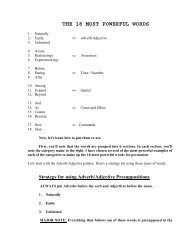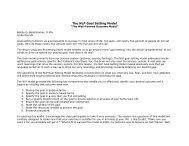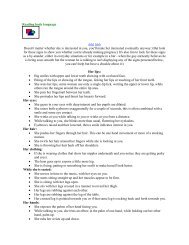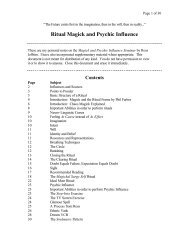A Pragmatic Guide To Communication & Change.pdf - NLP Info Centre
A Pragmatic Guide To Communication & Change.pdf - NLP Info Centre
A Pragmatic Guide To Communication & Change.pdf - NLP Info Centre
- No tags were found...
You also want an ePaper? Increase the reach of your titles
YUMPU automatically turns print PDFs into web optimized ePapers that Google loves.
fold. First, the person begins to feel more at ease with you and is more likely to trust you:<br />
"Ah! Someone who really understands me!" Second, you create an environment in which<br />
miscommunication is much less likely to occur. This is because you leave no room for<br />
contradictions between what you say or ask for and the internal experience - model of the<br />
world-of the person you are talking with. Also, because you are more "like" him in his<br />
experience, it is easier for him to "like" you.<br />
Representational System Hierarchies<br />
A person's preferred representational system is the one in which he generally makes the<br />
most number of distinctions about the world. One way to determine which system a<br />
person prefers is to give him the Representational System Bias Test (see Appendix 13 at<br />
the end of this book). By tallying the scores as shown, you can determine a person's<br />
representational system hierarchy." His preferred system will have a higher score than his<br />
secondary system, and so on. This "ranking" of a person's representational systems has<br />
some important ramifications. As demonstrated in previous examples, difficulties can<br />
arise when two people who need to communicate each have different preferred systems.<br />
This is especially true when the difference between the scores is large as in the example<br />
below.<br />
Person A: V-7 K-20 A-10 1)-13<br />
Person a: V - 20 K - 6 A - 9 D - 15<br />
47<br />
44<br />
Let us imagine that the well-intentioned counselor decides to respond to the above<br />
situation by turning to the woman and saying, "It's obvious that you are upset. What are<br />
your feelings telling you? Speak from your guts; share your emotions with us." In this<br />
hypothetical example, the woman might reply with: "Well, I don't really know what you<br />
mean. It just seems that everything I do is wrong. Things just aren't<br />
45<br />
what I pictured they would be when I got married, and my husband doesn't even seem to<br />
care!"<br />
The key to this interaction is in the woman's response to the counselor. She is being very<br />
honest with him when she says she really doesn't know what he means. For him to persist<br />
in asking her to "contact those feelings" or to "get in touch with her emotions" may lead<br />
to a counterproductive session. This is a situation where using the same "language" as the<br />
client could prove invaluable. Once he gains rapport with the woman, once she has the<br />
sense that he really "understands" her, then he can begin to systematically alter his<br />
language, "translating" the language of one system into another in order to effectively<br />
communicate with both her and her husband. The next step is to teach the couple to speak<br />
and understand each other's language. This can be done either overtly by talking about the<br />
use of predicates or through example, by simply continuing to "translate" whenever<br />
appropriate.<br />
Functional Differences<br />
It is perhaps the "mismatching" of predicates that accounts in part for the<br />
confounding fact that "great" therapists can work miracles with some clients but<br />
are almost totally ineffective with others. Preferred representational systems may<br />
also play an important role in a therapist's choice of which psychotherapeutic
















